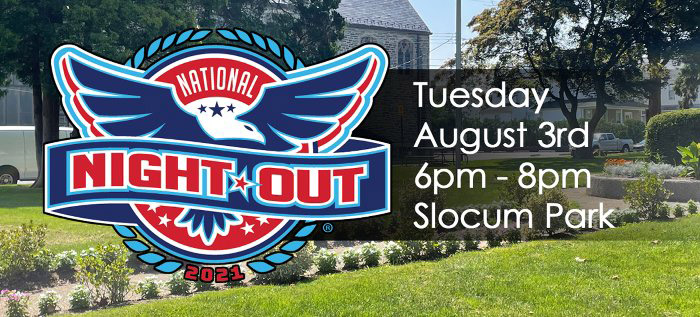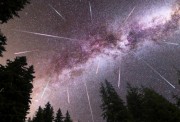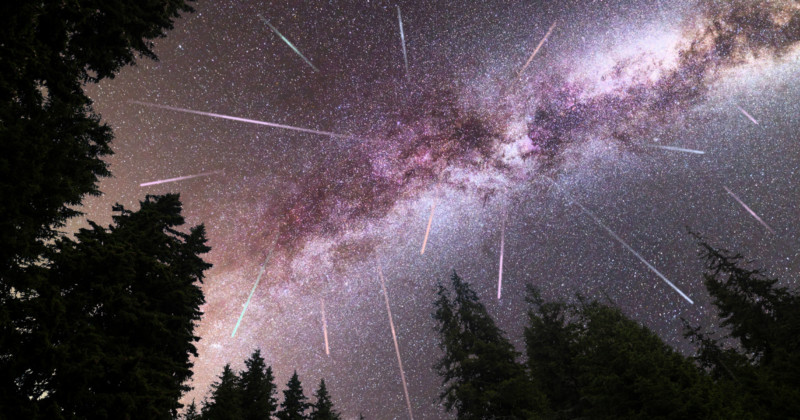
Long Branch Library announcing upcoming events and programs
August 2, 2021
Bob Moses, civil rights activist, and educator passed away at the age of 86
August 2, 2021 The State We’re In by Michele S. Byers – Long before fireworks were invented, our ancient ancestors watched the night sky for entertainment and inspiration. They saw changing moon phases, imagined animal and human shapes in the stars, and created elaborate myths about the constellations. And they’d spot meteors streaking across the sky, and comets with bright tails.
The State We’re In by Michele S. Byers – Long before fireworks were invented, our ancient ancestors watched the night sky for entertainment and inspiration. They saw changing moon phases, imagined animal and human shapes in the stars, and created elaborate myths about the constellations. And they’d spot meteors streaking across the sky, and comets with bright tails.
All these millennia later, the night sky still enchants. One of the most magical sights can be seen now: the annual Perseid meteor shower, when “shooting stars” look like they’re popping out of the constellation Perseus. In Greek mythology, Perseus is the son of the god Zeus and the mortal Danaë, and the shower of gold in the night sky commemorates their union.
This year conditions are promising, as the peak of the Perseid meteor shower nearly coincides with the new moon. Without moonlight, the meteors will seem brighter and easier to see. The Perseids are expected to produce the greatest number of meteors from Aug. 11 through 13 – up to 60 an hour – although the nights before and after the peak could also be very good.
 Meteor showers are caused by debris from comets hitting the Earth’s atmosphere. Every year from about July 17 to Aug. 24, the Earth crosses the orbital path of Comet Swift-Tuttle. Pieces from the comet’s debris cloud burn up as they slam into the Earth’s upper atmosphere, creating bright streaks in the night sky.
Meteor showers are caused by debris from comets hitting the Earth’s atmosphere. Every year from about July 17 to Aug. 24, the Earth crosses the orbital path of Comet Swift-Tuttle. Pieces from the comet’s debris cloud burn up as they slam into the Earth’s upper atmosphere, creating bright streaks in the night sky.
Meteors will be visible at any time after it gets fully dark after about 9:30 p.m., and the rate of meteors will continue to increase until around 4:30 a.m. The best time to see them will be after 2 a.m. and before the earliest light of dawn, because that’s when the eastern portion of the Earth is rotating toward meteor-filled, “new” space that has not already been swept clean.
The peak time for the Earth to run into the comet’s debris is about 7 a.m., but unfortunately you can’t see anything then because the sun is up. The Earth is like a fast, giant bulldozer, plowing through space as it orbits the sun at nearly 67,000 miles per hour!
Watching the Perseids at their peak is an incredible and unforgettable summer experience.
But in many places on Earth, it’s hard to see any meteor showers, constellations or other celestial bodies because of urban light pollution. Much of northeastern New Jersey, for example, is lit up too brightly to get a clear view, as is the Philadelphia-Camden metropolitan area to the southwest.
However, this state we’re in does have some “dark sky” areas with stellar viewing opportunities. Many of them are protected public lands like parks and nature preserves.
Here are some tips for viewing the Perseids:
Choose a dark sky area. New Jersey’s best dark sky areas include the Pine Barrens, Island Beach State Park, and sparsely populated regions like the northwestern counties and the Delaware Bayshore. Check out the website www.lightpollutionmap.info to find the darkest spots.
Find a location with a wide-open view. The fewer trees or structures to block the sky, the better your chances at seeing the full path of meteors. Parks are a natural choice, but even a parking lot without lights could do.
Watch in the early morning hours.
Look toward a wide area to the north and northeast. Perseus is near the constellation Cassiopeia, which is distinctive for its zigzag star configuration resembling the letters M or W. The northern tip of Perseus features the famous Double Cluster of stars. Perseid meteors will appear to shoot out from this part of the sky.
Plan for at least an hour of observing time. Your eyes can take up to 20 minutes to adjust to the darkness, so be patient. Resist the temptation to look at your phone, as that will reduce your night vision. Meteors often come in spurts, with lulls in between.
 No special equipment or knowledge is needed. Binoculars and telescopes won’t help you spot meteors; they’ll actually reduce your chances by narrowing your field of vision. (But if you want to bring them along for gazing at stars and planets, that’s great!)
No special equipment or knowledge is needed. Binoculars and telescopes won’t help you spot meteors; they’ll actually reduce your chances by narrowing your field of vision. (But if you want to bring them along for gazing at stars and planets, that’s great!)
Get comfortable! Bring a reclining lawn chair, beach chair or a blanket. Pack a sweatshirt in case the night gets chilly, and bring snacks.
Keep your fingers crossed for clear weather, and enjoy the show while it lasts! Even if you can’t make it to one of New Jersey’s dark sky areas, you may still be able to see some of the brighter Perseids meteors.Look for open spots without lights nearby.
And please support efforts to preserve New Jersey’s remaining dark sky locations!
The International Dark Sky Association believes a dark night sky is a part of our “common heritage” and is in danger of being lost for younger generations. And a growing body of research suggests that the loss of dark skies can impact both human health and the rhythms of the natural world.
 To learn more about dark skies and how to protect them, visit the International Dark Sky Association website at https://www.darksky.org/.
To learn more about dark skies and how to protect them, visit the International Dark Sky Association website at https://www.darksky.org/.
And for information about preserving New Jersey’s land and natural resources – including dark sky areas – visit the New Jersey Conservation Foundation website at www.njconservation.org or contact me at info@njconservation.org.





